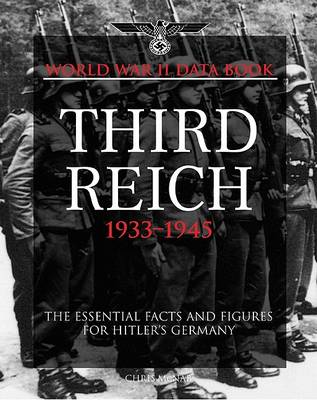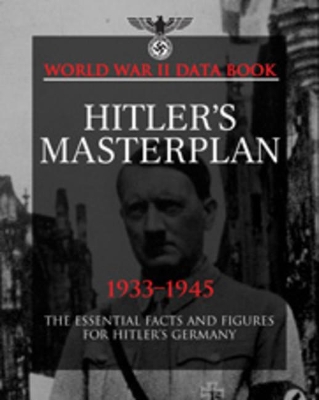World War II Germany
3 total works
'The best political weapon is the weapon of terror. Cruelty commands respect. Men may
hate us. But we don't ask for their love; only for their fear.'
- Himmler
Most people would associate the SS with Heinrich Himmler, but the latter was not the
first (or the last) leader of this infamous body. SS 1923-
1945 examines the history and development of the Schutzstaffel from its origin as Hitler's
personal bodyguard to its growth into a millions-strong organisation by the war's end in
1945.
Broken down by the key constituent parts of the SS, such as the police,
concentration camps, security services, Waffen-SS, slave labour, Einsatzgruppen and so
forth, the book includes exhaustive reference tables, diagrams, maps and charts,
presenting all the core subject information in easy-to-follow formats.
The SS 1923-1945 will be an essential reference guide for
anyone interested in the history or demographics of this infamous organisation.
hate us. But we don't ask for their love; only for their fear.'
- Himmler
Most people would associate the SS with Heinrich Himmler, but the latter was not the
first (or the last) leader of this infamous body. SS 1923-
1945 examines the history and development of the Schutzstaffel from its origin as Hitler's
personal bodyguard to its growth into a millions-strong organisation by the war's end in
1945.
Broken down by the key constituent parts of the SS, such as the police,
concentration camps, security services, Waffen-SS, slave labour, Einsatzgruppen and so
forth, the book includes exhaustive reference tables, diagrams, maps and charts,
presenting all the core subject information in easy-to-follow formats.
The SS 1923-1945 will be an essential reference guide for
anyone interested in the history or demographics of this infamous organisation.
The 'Thousand Year' Reich actually lasted from January 1933 until May 1945, but in that time Germany underwent radical transformation. The Third Reich 1933-1945 examines the Third Reich, from its population changes to its organizational structures, building into a detailed compendium of information. Broken down by key subject areas such as the economy, geography, military, religion, politics, law and crime, culture, and racial and social policy, the book includes comprehensive reference tables, diagrams, maps and charts, presenting all the core subject information in easy-to-follow formats. The Third Reich 1933-1945 will be an essential reference guide for anyone interested in the history or demographics of the Third Reich.
How would Europe have looked if Nazi Germany had been victorious in World War II? Between 1933 and 1945, Hitler developed a vision for an infrastructure, architecture, race, labour force and Lebensraum – the acquiring of `living space’ – among many other plans. Some of these were implemented during his leadership as the German Wehrmacht expanded the Nazi sphere of influence, but what were the unrealised plans for a Europe dominated by the Third Reich?
A racially-based order would have been established across European Russia, with former German soldiers running farms worked on by slave labour. Germany and Japan were to carve up the Soviet Union and Asia between them. Berlin was to be rebuilt as Germania, a world capital city designed on grandiose, neo-classical lines. Arranged in chapters covering topics such as leadership, war, physical infrastructure, empire building, race, culture and weaponry, World War II Data Book: Hitler’s Masterplan, 1933–45 reveals the true scale of Hitler’s vision for a Greater Germany and a world dominated by the Nazi ideology. Packed with easy-to-understand maps, diagrams, graphs and illustrations, this is an essential reference guide for anyone interested in modern European history.
About the Author
Chris McNab is a survival expert, military specialist and author of over 20 military publications including Twentieth Century Small Arms, The Encyclopedia of Combat Techniques, The Illustrated History of the Vietnam War and co-author of Tools of Violence, as well as contributing to The Times on the war in Iraq.
A racially-based order would have been established across European Russia, with former German soldiers running farms worked on by slave labour. Germany and Japan were to carve up the Soviet Union and Asia between them. Berlin was to be rebuilt as Germania, a world capital city designed on grandiose, neo-classical lines. Arranged in chapters covering topics such as leadership, war, physical infrastructure, empire building, race, culture and weaponry, World War II Data Book: Hitler’s Masterplan, 1933–45 reveals the true scale of Hitler’s vision for a Greater Germany and a world dominated by the Nazi ideology. Packed with easy-to-understand maps, diagrams, graphs and illustrations, this is an essential reference guide for anyone interested in modern European history.
About the Author
Chris McNab is a survival expert, military specialist and author of over 20 military publications including Twentieth Century Small Arms, The Encyclopedia of Combat Techniques, The Illustrated History of the Vietnam War and co-author of Tools of Violence, as well as contributing to The Times on the war in Iraq.


